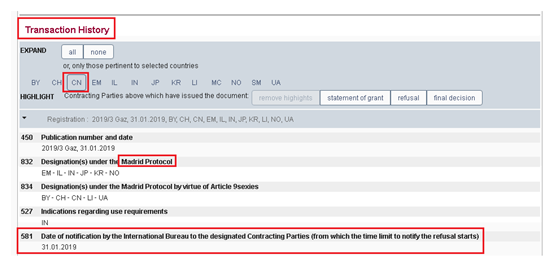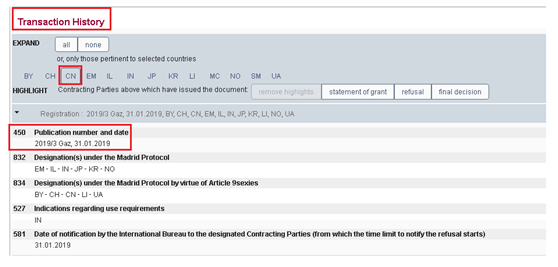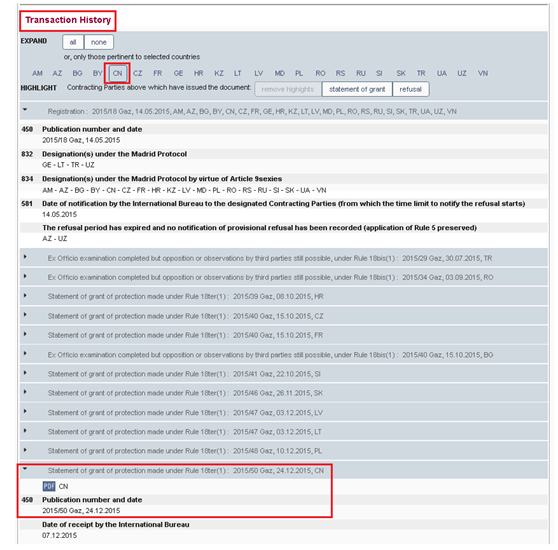


Nowadays many applicants choose to register their marks through Madrid (WIPO), on the basis of their own national applications / registrations, and at the same time, or at a later stage, designating many countries, including China. Today I would like to share something important regarding the international registration designating China (hereinafter IR (CN)), which will include 1) the CNIPA’s substantial examination of an IR (CN); 2) notification of amendment / opposition / invalidation / non-use cancellation against an IR (CN);3) if the basic national applications / registrations is cancelled, how about the Chinese designation?
1. The CNIPA’s substantial examination of an IR (CN)
Frankly speaking, after the CNIPA’s substantial examination, almost 30-40% IR (CN) will encounter refusal due to the large amount of existing applications/ registrations in China, so if you intend to designate China, you’d better conduct a formal trademark search, in order to reveal any potential obstacles and take necessary actions prior to the designation.
Since WIPO does not substantially examine an international registration, after an IR (CN) is filed, WIPO will forward the application to the CNIPA. After the CNIPA receives the WIPO’s notification, the examination starts and the CNIPA must finalize the examination within 18 months (under Protocol). Take the following mark as an example:

This mark is designated under the Madrid Protocol and the date of notification from the international Bureau to the CNIPA is January 31, 2019, so the CNIPA had to issue a substantial examination decision on or before July 31, 2020 (i.e within 18 months).
If the IR (CN) is approved for extension, the CNIPA will not issue a publication publishing the decision. If the IR (CN) is refused for extension, the CNIPA will issue a notification of refusal back to the international Bureau, and then the international Bureau will forward the notification, with a cover page, to the representative. The applicant has the right to file review on the refusal within 15 days from the receipt of the notification.
2. Notification of amendment / opposition / invalidation / non-use cancellation against an IR (CN)
1) Notification of amendment
Sometimes, if the designated goods / services are those the CNIPA does not accept, the CNIPA will issue a notification of amendment under the form of refusal notification, however, it is not a true refusal notification but a notification of amendment. What goods and services are not able to be accepted by the CNIPA? Up to now and according to our acknowledge, they are wholesale and detail related service, gambling related services, and ivory products. For these goods and services, if the CNIPA issues a notification, we do not suggest responding to it; instead, we suggest accepting the deletion of the above goods and services directly, since for the above goods / services, the CNIPA does not accept any explanation, or amendment.
2) notification of opposition
Please note for an IR (CN), the opposition procedure is parallelly with that of a substantial examination. The opposition deadline is the last day of the third month from the next month of the publication date of registration. After the international Bureau receives an opposition application, it will issue a notification to the representative and the applicant should file response within 45 days since the issuance date of the opposition notification. According to China Trademark Law, the CNIPA should issue a decision within 12 months since receipt of the opposition application. Take the above mark as an example again:

The publication date of the registration is January 31, 2019. The deadline to file an opposition is April 30, 2019.
Additional tips: if an IR (CN) encounters both opposition and official refusal, and if the applicant files a review on the refusal, since the examination of opposition and substantial examination and the corresponding review on refusal are examined parallelly, if the mark is successfully opposed, the CNIPA will close file for the examination of review on refusal and if the mark is finally refused for extension (i.e. the applicant loses the review on refusal), the CNIPA then will close file for the opposition.
3. notification of non-use cancellation against an IR (CN)
The precondition of a non-use cancellation is the IR (CN) has been already approved for extension protection in China. So the first thing is to check whether the IR (CN) has been already approved for extension protection in China:
1) if there is a “statement of grant of protection” under the records of CN part of an IR (CN), the date that the mark is vulnerable to non-use cancellation is 3 years after the publication date, please see below:

After December 24, 2018, the mark is open to non-use cancellation.
2) if there is no such a “statement of grant of protection” under the records of CN part of an IR (CN), and there is no official refusal notification either, the date that the mark is vulnerable to non-use cancellation is 3 years after the publication date of the registration, plus 18 months, please see below:

This IR (CN) did not encounter official refusal, so after March 3, 1997 (September 3, 1992 + 18 months + 3 years), it is open to non-use cancellation.
3) If there is no such a “statement of grant of protection” under the records of CN part of an IR (CN), and there is an official refusal notification, we need to check further with the CNIPA to find out whether there is a review on refusal or whether the mark is active.
4. Notification of invalidation against an IR (CN)
Similar to non-use cancellation, the precondition is the IR (CN) has been already approved for extension protection in China. The ways to check the status of the IR (CN) is the same as those of non-use cancellation. Please note that the invalidation action should be filed within 5 years after it is officially approved for extension, unless the cited mark is a well known mark.
5. If the basic national applications / registrations is removed / cancelled, etc, how about the Chinese designation?
Generally speaking the national basic applications / registrations are the roots of IR (CN)s, the cancellation or removal the basic applications / registrations will affect the Chinese designations. The CNIPA provide a way to rescue the Chinese designations—transferring the IR (CN) as a Chinese national registration. The international Brureau will issue a notification to the representative of the fact that the basic registration is invalid; the applicant could file application to transfer the IR (CN) as a Chinese national registration within 3 months since receipt of the WIPO notification.
All in all, the international registration is a convenient way to have one registration designating various countries, but it does has many differences from national registrations, so we need to learn more the take better care of our international registrations.
Ester Eggs:
Sometimes, we could see that there are certain letters in front of or at the end of an IR No., what do they mean? This is this article’s Ester Egg for you.
G: international registration
H: re-designating China once
H2: re-designating China twice
A: assigned once
B: assigned twice

Follow us




